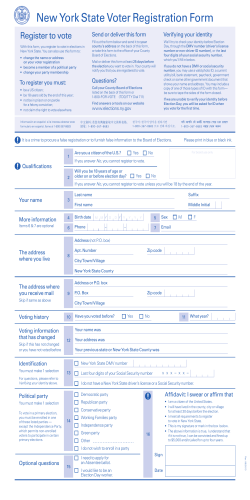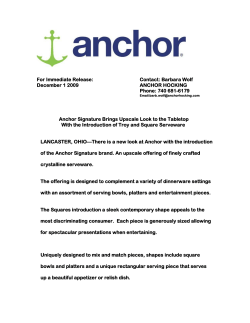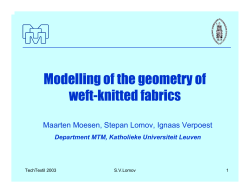
How To Win A General Election By A Landslide Victory Peter Jones
M PRA Munich Personal RePEc Archive How To Win A General Election By A Landslide Victory Peter Jones Economic Development Institute Jamaica 19. August 2006 Online at http://mpra.ub.uni-muenchen.de/4243/ MPRA Paper No. 4243, posted 24. July 2007 How To Win A General Election By A Landslide Victory Peter W Jones 2 Abstract Some political parties have become victims of high technology politics; especially those in Latin America and the Caribbean who continue to practice limited database thinking. Those who have continued to practice political rule by thuggarism have found themselves behind the political curve of win ability, as the short– termism of this policy lacks sustainability beyond a year. The politics of the end of 20th century and now that of the 21st century has been seriously influenced by Globalization and its intrinsic facets of economic and financial marginalization and or redefinition of power. Many worldwide have used these high technology political strategies to maintain power and retain power when elections have been called. Those who live in the realm of Democratic idiocy will never hold the reigns of power, merely tasting it from time to time as the election political wind blows but never really harnessing its effective power. A good political platform speech is of importance. However, a good platform speech with strong subliminal suggestion and content and intention can never be duplicated. Some have this gift, some learn it while others never quite get there and automatically become a victim of the social, economic and political whirlwind of the New Global Informational Politics which is being used to manipulate uneducated , low educated or poorly educated voting populations worldwide. Peter W Jones August 19, 2006 4 TABLE OF CONTENTS ABSTRACT........................................................................................... 3 OVERVIEW .......................................................................................... 5 POLICY SCENARIO ............................................................................... 5 THE POLITICAL POLICY ANCHORS ........................................................ 5 IMPACT OF THE POLITICAL ANCHORS ................................................... 7 THE STABILIZATION STRATEGIES ......................................................... 9 OVERVIEW OF THE THEORETICAL MODELS ........................................... 9 POLITICAL MANIPULATION? ............................................................... 10 POINTS FOR ASPIRING POLITICIANS TO CONSIDER ............................. 11 CONCLUSION .................................................................................... 12 How To Win A General Election By A Landslide Victory 5 ―Victory at all costs, victory in spite of all terror, victory however long and hard the road may be; for without victory there is no survival.‖ Winston Churchill Overview It is clear that politics influences economic policy. Determining the extent to which this happens is quite a challenge, particularly for researchers studying developing countries. It is a challenge worth meeting, however, because failing to design the appropriate policy may have a major negative impact on the welfare of these societies. Policy Scenario An example of a policy with a high political dimension and strong welfare impact is the choice of nominal anchor to stabilize inflation. In response to high and chronic inflation, many countries have adopted stabilization policies. These policies differ in their design, but to what extent these differences arise from political, rather than economic, motives is not clear. Nor is it known whether and to what extent policymakers take advantage of the consumption cycles derived from the different stabilization strategies in order to further their political career. The Political Policy Anchors There are basically two possible anchors available for policymakers to stabilize inflation: the exchange rate and a monetary aggregate. These alternatives lead to two different consumption paths even if to the same end result in terms of welfare. Exchange rate- based stabilization programs generate 6 an initial consumption boom and later a recession in the economy whereas money-based stabilizations generate an early consumption bust followed by a recovery. A benevolent dictator might be indifferent to the differences between both strategies but elected officials must be sensitive to the reaction of voters. If voters are not perfectly forward looking, then the timing of elections might matter, and knowledge of these consumption patterns allow politicians to use both nominal anchors opportunistically. In particular, an opportunistic politician might use exchange-rate-based stabilizations prior to elections whereas monetary anchors might be employed after elections. Research out of the International Monetary fund using results derived from fairly simple econometric models using data on 34 full-fledged stabilization episodes clearly indicate that the timing of elections affect the choice of anchor for stabilization. In particular, policymakers assess how distant the next elections are before making their choice of nominal anchor in the inflation stabilization program that they have decided to embark on. Estimates strongly suggest that the probability that policymakers adopt an exchange-rate based stabilization is higher when they are closer to the date set for future elections. The probability of adopting a money-based stabilization, on the other hand, is higher when future elections are far away and previous elections are closer. Moreover, the results show that the stock of international reserves available for policymakers, and the extent of the openness of the economy and fragmentation of the political power not only affect the choice of anchor to stabilize inflation but also the degree to which policymakers may be more or less opportunistic in their choice of anchor. For example, three different policymakers who decide to launch a 7 stabilization program at different moments of their election cycle will have, respectively, 45 percent probability of choosing the exchange rate as the anchor three years before elections, 78 percent two years before elections, and 99 percent one-year prior to elections, for the case where reserves cover 10 percent of M3. Likewise, other things being equal, a difference of about three years in the time remaining to next elections implies a difference of 24 percentage points in the probability of adopting an exchange-rate-based stabilization (76 percent five years before elections and 100 percent two years prior to elections). Impact Of The Political Anchors The political economy literature has documented the impact of elections on different economic variables ranging from public budget deficits to inflation and real exchange rate. In particular, theoretical and empirical papers have established that the existence of political opportunism in developing countries creates a common pattern where these different variables cycle around elections. Chronic inflation has been a major problem in the late 20th century for many countries in the developing world and especially in Latin America. The diverse stabilization attempts pursued in Latin America, Israel, Turkey, and Iceland have allowed some economists to identify unique stylized facts for each type of stabilization strategy. The debates over what strategy to adopt in order to stabilize the economy have been intense, and have been centered around whether exchange-rate-based stabilization (ERBS henceforth) is superior to money-based stabilization (MBS henceforth). Formally, the difference between these programs lies in the selection of the nominal anchor to bring inflation down to normal rates. The ERBS chooses the exchange rate as its nominal 8 anchor while the MBS traditionally adopts a monetary aggregate, such as M1 or monetary base. The consequences of the choice of the nominal anchor differ considerably and have important implications. The different experiences from the stabilization programs mentioned above have generated a very controversial literature regarding the effects of disinflation programs on consumption and output. Easterly (1996) in a study of a sample of stabilization programs has concluded that they are always expansionary. Kiguel and Liviatan (1992) and Végh (1992) study the business cycles associated with ERBS in chronic inflation countries concluding that they greatly differ from those associated with MBS. In particular, their study of a sample of stabilization episodes shows that the business cycle associated with ERBS begins with a boom and ends with a recession. Calvo and Végh (1999) analyze stabilization programs adopted in Latin America and Israel. The theoretical work and empirical results of their paper are important because of the stylized facts they help to establish. Table 1 shows the most relevant empirical regularities of ERBS and MBS considered in their paper. Exchange-rate based stabilization Money-based stabilization Slow convergence of the inflation rate to the rate of devaluation Slow convergence of the inflation rate to the rate of growth of the money supply Initial increase in real GDP and private consumption followed by a later contraction Initial contraction in economic activity Real appreciation of the domestic currency Real appreciation of the domestic currency Deterioration of the trade balance and current account deficit No definite response of the trade balance and the current account Ambiguous impact response of domestic real interest rates Initial increase in domestic real interest rates The Stabilization Strategies 9 The most striking difference between the two stabilization strategies is the real effects on economic activity. In particular, as described above, ERBS exhibit a consumption boom early on in the program followed by a later contraction. In contrast, MBS exhibit an initial consumption bust followed by a later recovery. The literature exploring these boom-bust cycles has concentrated on theoretical models replicating the empirical regularities in consumption following stabilization programs. The empirical literature sought to test what is known as the ―recession-now-versus-recession-later‖ hypothesis, making reference to the possibility of delaying the disinflation costs (recession) using the exchange rate as the nominal anchor. It is important to note that ERBS attempts often lead to balance-of-payments crisis, loss of international reserves, and major devaluations. Therefore, exante, it is not a simple task to determine which stabilization strategy should be pursued, since initial consumption booms are definitely an advantage of ERBS over MBS. This might be especially true if the economy is in a recession prior to the launching of the program. Overview Of The Theoretical Models Calvo and Végh (1999) also provide theoretical models to explain consumption boom-bust cycles. Perhaps one of the most important assumptions of their main model is that, at least a priori, one stabilization strategy should not be preferred over the other. The only difference between them depends on when the stabilization costs will be paid — earlier in the case of a MBS and later in the case of an ERBS. In other words, in an infinite horizon economy, the present value of consumption after the adoption of either stabilization strategy can be assumed to be equal. 10 In spite of the distinctive empirical regularities following ERBS and MBS described by Calvo and Végh (1999), some studies in the recent literature dispute their validity. Echenique and Forteza (1997) re-examine the existence of consumption and output cycles after ERBS and conclude that they have taken place because the ERBS are generally launched when the world economy is booming and the country has experienced positive terms-of-trade shocks. Therefore, they conclude that the consumption booms after ERBS were more the direct result of positive macroeconomic shocks than of a particular choice of nominal anchor. Gould (2001) argues that the initial consumption boom and bust in ERBS and MBS are endogenously determined by the initial conditions such as initial GDP and the level of international reserves of the different economies and bear no relation with the choice of anchor to stabilize inflation. Political Manipulation? It is natural to ask how opportunistic politicians can choose their policies to their own benefit and still be reelected. The traditional literature has attributed two main alternatives regarding voters’ behavior that are theoretically consistent with political opportunism. 1. According to the first tradition (Nordhaus, 1975), voters may be myopic or short-sighted. The implications of assuming backward-looking adaptive expectations are straightforward: voters base evaluations on the recent past and thus reward governments producing consumption booms before elections. 2. Alternatively, a later tradition appeared with newer models based on the ―politician’s competence‖ (Rogoff 1990) where voters have rational expectations but lack information regarding the level of competence of the different politicians. 11 The implications of assuming rational expectations are that politicians make every effort to signal their type to voters by successfully generating a consumption boom before elections with either a MBS or an ERBS depending how distant are future elections. Edwards (1994) provides evidence that adaptive expectations models (retrospective voting) outperform rational expectations models of political business cycles in Latin America. Even so, since consumption booms prior to elections can be engendered by both traditions, it is safe to remain agnostic about what should be the appropriate variant. In fact, this paper provides results that should be consistent with both theories of voter behavior. Points For Aspiring Politicians To Consider The most important result of this paper is the observed pattern regarding the choice of anchor to stabilize inflation in high and chronic inflation countries. In particular, since ERBS generate an initial consumption boom they are on average adopted before elections and since MBS generate an initial recession they are on average launched after past, and faraway from future, elections. 1. This paper also provides a rationale for why policymakers may choose a short-run hard MBS. It seems advantageous to do it right after elections for two reasons. First, because economic recovery will take place during the term of office of the politician and, 2. second, because the politician may blame the previous government for the costs implied by the adoption of the MBS. Additionally, it can be an alternative strategy for some countries that, due to the numerous failed attempts, might have exhausted the ability to use the exchange rate as the nominal anchor. 3. Most importantly, this paper provides insight on the motivations behind the policymakers’ choice of anchor to achieve low inflation. A relatively 12 large stock of international reserves, a high level of openness, and high political fragmentation not only increase the probability of adoption of an ERBS but also affect the degree of political opportunism behind the choice of nominal anchor for stabilization. Conclusion This paper has suggested some possible theoretical channels that can be used to explain the facts that were obtained: 1. Voters’ behavior and the ability of policymakers to opportunistically choose economic policies are essential ingredients in the construction of an interesting theoretical model. 2. The main objective of this paper was to seriously document the economic and political variables affecting the decision over the anchor to stabilize inflation without taking any position in favor of a particular theoretical model of political opportunism or voting behavior. 3. It is not surprising that politicians choose economic strategies that align with their own goals of re-election. Depending on how widespread this behavior (see table 2 & 3) is within a country, this may suggest that stronger institutional arrangements that oversee politicians could reduce the degree of political opportunism benefiting societies in many developing countries. 13 TABLE 2 JAMAICAN DATA 1997/8 1998/9 $JA(Billions) $JA(Billions) 21.72 21.807 38.1 Net International Reserves (NIR) Exchange Rate(End Od Period) ($US/JA) 1999/0 $JA(Billions) 29.899 42.2 2000/1 $JA(Billions) 57.883 45.7 2001/2 $JA(Billions) 94.753 47.5 2002/3 $JA(Billions) 87.9 56.1 Source: IMF Article IV 2003 & 2004 TABLE 3 JAMAICAN IMPORTS 1999 IMPORTS $JA'000 2000 IMPORTS $JA'000 2001 IMPORTS $JA'000 2002 IMPORTS $JA'000 ALL SECTIONS 115,690,225 141,986,736 154,799,256 19,344,285 FOOD 17,969,547 19,231,697 21,899,825 3,962,022 BEVERAGES &TOBACCO 1,271,835 1,169,438 1,387,916 1,082,063 CRUDE MATERIALS 2,004,156 2,224,431 2,158,594 10,136 MINERAL FUELS LUBRICANTS 16,421,471 27,961,289 27,122,564 10,112,413 ANIMAL & VEGETABLE OILS &FATS 820,017 846,337 788,434 143,911 CHEMICALS 13,351,110 16,141,395 17,264,771 1,325,511 MANUFACTURED GOODS 17,132,954 19,029,430 21,446,750 1,881,737 MACHINERY & TRANSPORT EQUIPMENT 25,801,624 32,220,846 40,512,298 218,207 MISC. MANUFACTURED ARTICLES 17,272,441 19,377,008 18,141,990 608,286 OTHER 3,645,070 3,784,865 4,076,114 0 Source: Statistical Institute Of Jamaica 14 Peter Jones is the Executive Director Of The Economic Development Institute a Non-profit Jamaican Economic Development Consultancy. Mr. Jones holds Post Graduate degrees in Economics and Business Administration and is the author of Jamaica 2030: A Strategy For Developed Country Status.
© Copyright 2025











